Intro
We often lament how expensive modern flagships are, but the truth of the matter is that there are amazing value propositions out there. The Pixel 9a and the Nothing Phone (3a) Pro are both in that camp, and both of these phones offer a great bang for your bucks.
The Pixel 9a is another great A-series device that’s even threatening Google’s own flagship series among other competitors. The Nothing Phone (3a) Pro, on the other hand, tries to be the buffed-up midranger you’d be tempted to choose over affordable and not-so-affordable flagships. Let’s see which one of these two will win the battle.
Pixel 9a vs Nothing (3a) Pro differences:
| Pixel 9a | Nothing Phone (3a) Pro |
|---|---|
| More compact device at 154.7 x 73.3 x 8.9 mm | Bigger footprint with dimensions 163.5 x 77.5 x 8.4 mm |
| Weighs less thanks to the smaller footprint at 186 grams | Substantially heavier at 211 grams |
| Smaller 6.3-inch OLED screen, 120Hz, 2700 nits | Much larger screen diagonal – 6.77 inches, 120Hz, 3000 nits |
| Android 15 out of the box, seven major OS updates (up to 2032) | Android 15 out of the box |
| The latest Tensor G4 chipset with the latest AI instructions onboard | Snapdragon 7s Gen 3 (4 nm) close to the Tensor in raw performance |
| Two cameras – a 48MP main sensor and a 13MP ultra-wide | Main camera is 50MP, and the ultrawide camera is 8MP |
| No telephoto camera | 50MP periscope zoom camera with 3x optical zoom |
| Bigger battery at 5100 mAh delivering better battery life | Slightly smaller 5000 mAh battery |
| Slightly slower charging – 23W wired | Faster 50W wired charging, 50% in 19 minutes, 100% in 56 minutes |
| Wireless charging with 7.5W of power | No wireless charging |
| Potentially more expensive – $499 for the 128GB version | Cheaper price at $459 for the base 256GB version |
| Two storage options – 8GB/128GB and 8GB/256GB | One storage option with more RAM and onboard memory – 12GB/256GB |
Table of Contents:
Design and Size
Does unique design still matter?
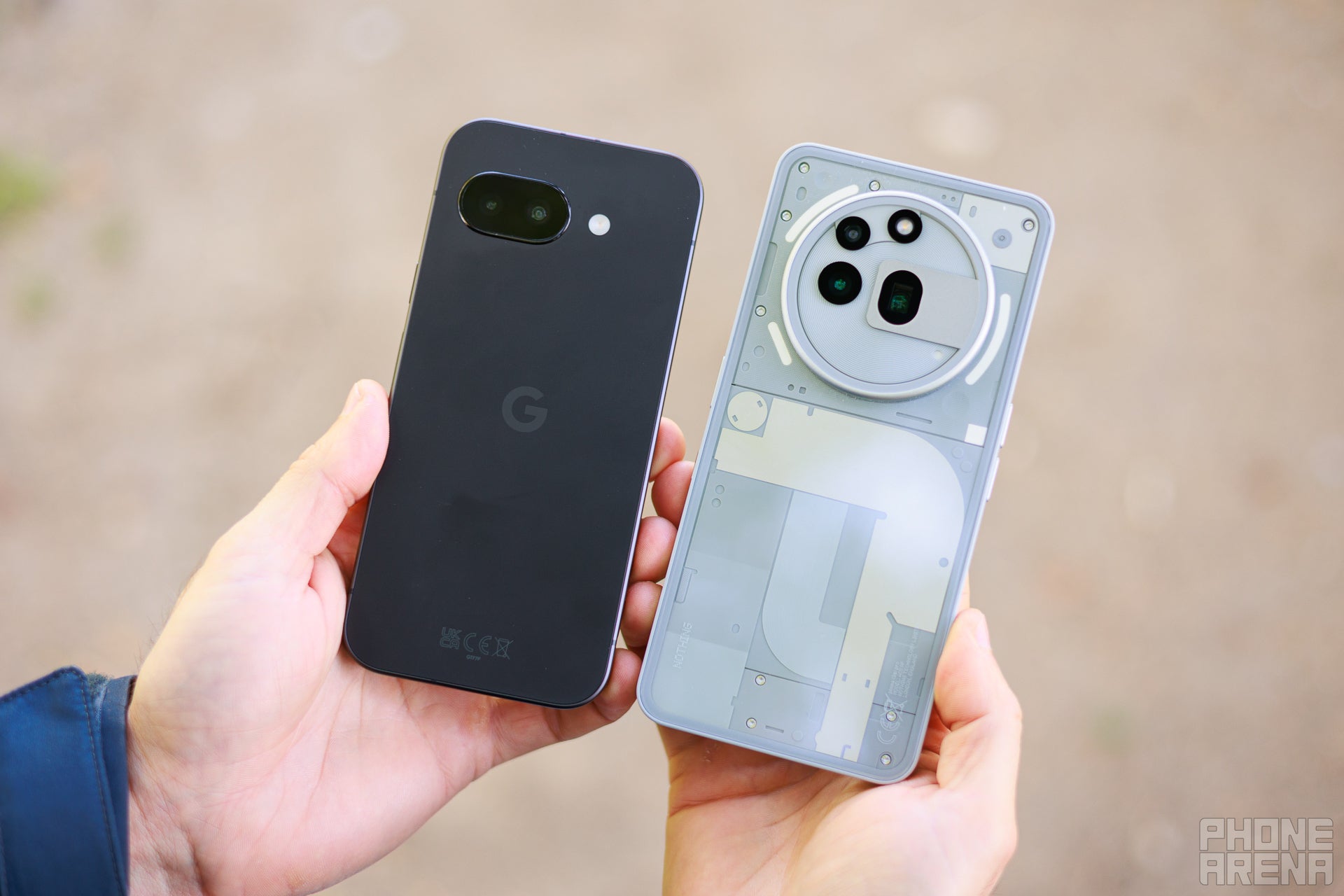
The Nothing Phone (3a) Pro is bizarre and wacky in the same positive way, and even the placing of the different cameras raises eyebrows. That’s not a bad thing, and in fact, it’s one of the reasons some people might reach out and grab a unit.
The Pixel 9a, on the other hand also tightly follows the recent design language Google has demonstrated with the regular Pixel 9 series. The phone features a flat front and back, flat sides, and an oval camera housing almost flush with the body of the phone.
Of course, there’s a significant difference in size and weight between these two phones, due to the different screen sizes. You can find the detailed dimensions below.
154.7 x 73.3 x 8.9 mm, 186 grams
Nothing Phone (3a) Pro dimensions and weight:
163.5 x 77.5 x 8.4 mm, 211 grams
Another big difference lies in the building materials used for the Nothing Phone (3a) Pro and the Pixel 9a. The former employs transparent glass on the back, while the Pixel 9a features a plastic composite back and a painted metal frame.
Now, plastic may sound cheap, but there are different polymers that feel differently, some of which may very well feel almost like glass. So, we shouldn’t label the Pixel 9a plastic back as “cheap,” at least not before we’ve tried it ourselves.
On the color front, the Pixel 9a is available in more colors, while the Nothing Phone (3a) Pro comes in just two monochromatic hues.
Pixel 9a colors:
- Obsidian
- Porcelain
- Iris
- Peony
Nothing Phone (3a) Pro colors:
Display Differences
Do you like big screens?
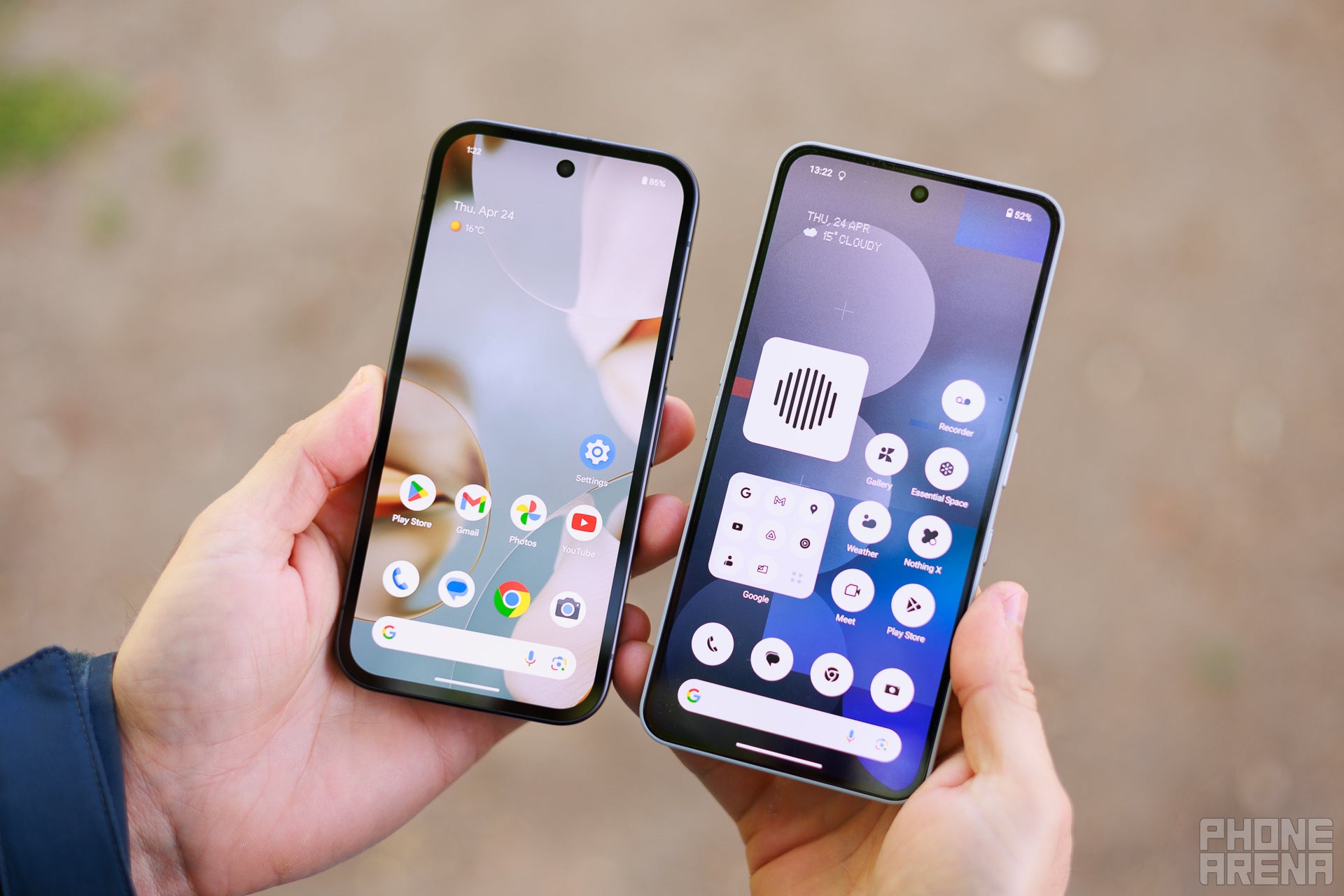
The smartphone as we know it is moving toward larger and larger screens, and this is evident in all “compact” flagships. Vanilla iPhones and Galaxies used to be 6.1 inches, and they’re slowly growing to 6.2 and 6.3-inch diagonals.
The Nothing Phone (3a) Pro, on the other hand, feels massive in comparison, with its 6.77-inch OLED display. The device features more or less the same FHD+ resolution (1080 x 2392 pixels), which, due to the bigger size of the screen, results in lower pixel density—around 387 PPI.
The panel is LTPO as well, reaching a maximum refresh rate of 120Hz, while the brightness figures are even more impressive at 3000 nits peak. We were able to measure around 1400 nits on the Nothing Phone (3a) Pro during our display tests, which is a decent result.
Performance and Software
The Tensor might win something, finally
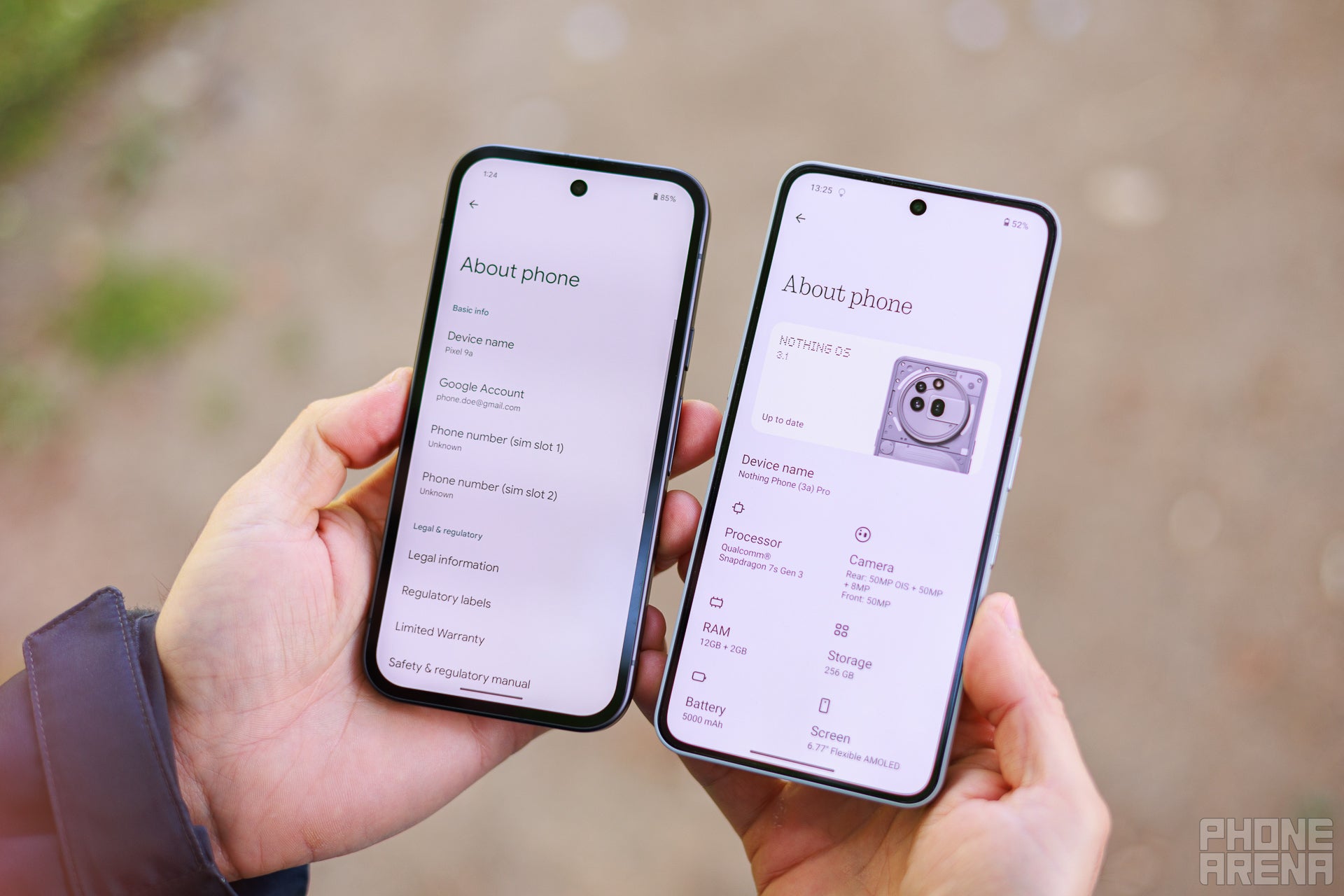
The Nothing Phone (3a), on the other hand, comes equipped with the Snapdragon 7s Gen 3 onboard. This 4nm chipset is often compared to the 8 Gen 2 in raw performance and occupies the midrange benchmark territory. The Tensor chips have been losing to flagship Snapdragon processors for so long now that it will be a surprising win, at least in this particular comparison. Let’s check out the scores.
In terms of RAM and storage, strangely enough, the Nothing Phone (3a) Pro has an advantage. It comes in only one configuration, featuring 12GB of RAM and 256GB of storage. In comparison, the Pixel 9a offers the same base 8GB RAM and 128GB storage as its predecessor with a step-up version that mimics the storage of the Nothing Phone (3a) Pro.
Software-wise, the Pixel 9a is a Google phone, after all, and will benefit not only from the seven years of major OS updates pledge but also from getting those updates fast. Nothing offers three years of major OS updates for the Nothing Phone (3a) Pro and six years of security patches, so advantage Pixel!
Camera
Can a telephoto make a difference?
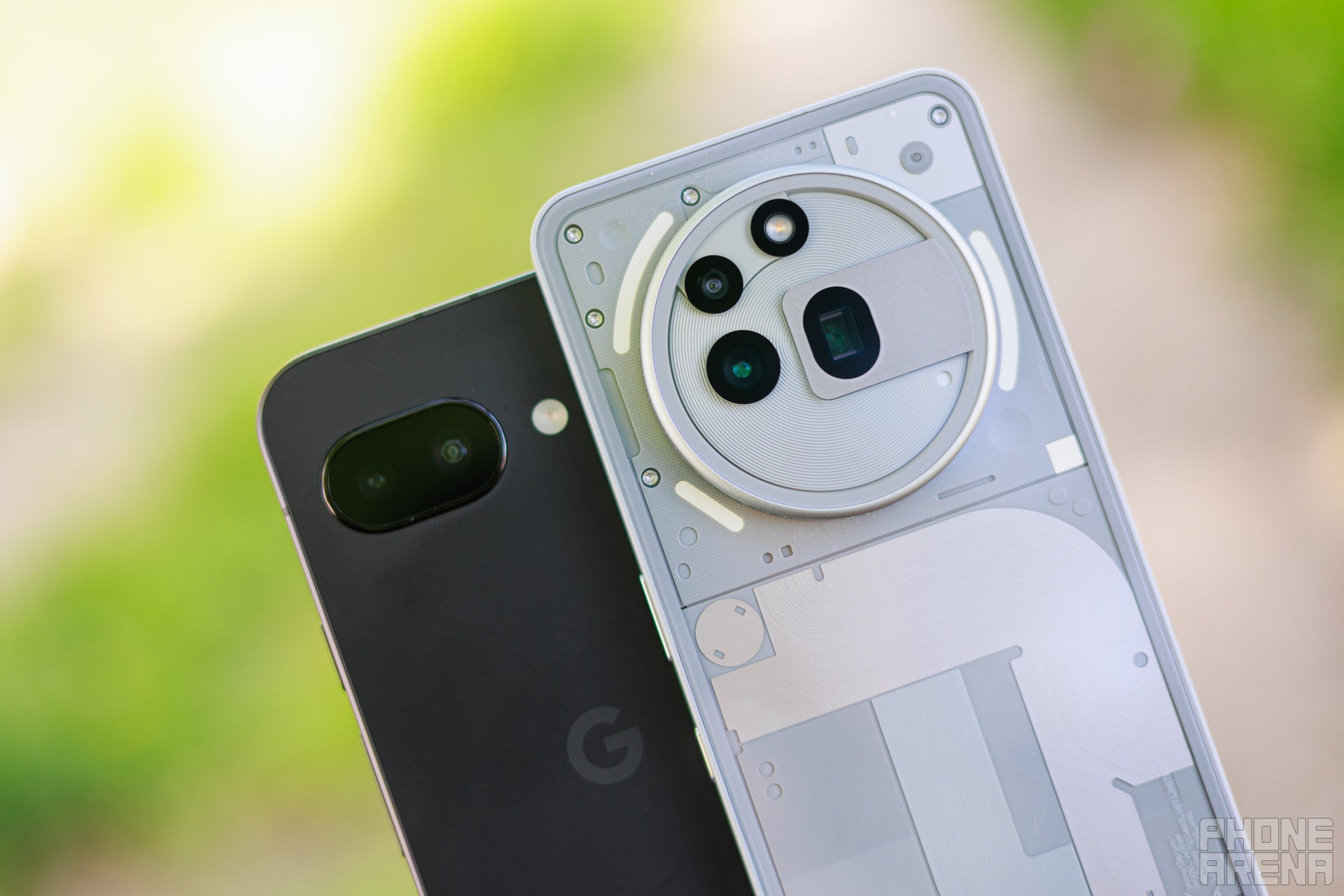
The main wide camera of the Pixel 9a uses a 48MP sensor (1/2.0″) and an f/1.7 aperture, resulting in a focal length similar to 25mm. This differs from the bigger 50MP sensor (1/1.56″) in the Nothing Phone (3a) Pro, which has an aperture of f/1.9 and a 1.0 µm pixel size.
The ultrawide cameras are also different—on the Pixel 9a, we have a new 13MP camera with an f/2.2 and 120-degree field of view. The Nothing Phone (3a) Pro, on the other hand, features a low-megapixel count 8MP ultrawide camera, with the same f/2.2 aperture but a much smaller sensor (1/4.0″).
What the Nothing phone has in its sleeve, however, is a 50MP periscope telephoto camera with 3x optical zoom and phase detection autofocus. The Pixel 9a relies on 2x crops from the main sensor, so zoom-wise the Nothing Phone (3a) Pro has an advantage, at least on paper.
PhoneArena Camera Score:
Our detailed camera tests in the lab confirmed the above. The Nothing Phone (3a) Pro managed a better zoom score, thanks to its dedicated periscope zoom lens, and also outperformed the Pixel 9a in the main camera category. The Pixel 9a retaliated with better ultrawide scores and better video, so in the end, the overall score landed very close between these two.
The side-by-side samples above paint a very similar picture to our lab tests. The Nothing Phone (3a) Pro produces main camera samples with better dynamic range and detail overall.
One thing that’s worth mentioning, though, is that color reproduction is a bit off on the Nothing Phone (3a) Pro – colors look quite saturated. If you dig this look, than it won’t be an issue. The Pixel 9a snaps more realistic photos but the lack the detail and dynamic range of the Nothing phone.
The other big advantage Nothing has over the Pixel in this particular comparison can be found in the zoom samples. Having a dedicated periscope zoom lens helps a lot, and the zoom images taken with the Nothing Phone (3a) Pro are noticeably clearer and more detailed.
Here’s a quick video comparison between the two devices:

Battery Life and Charging
Advantage Pixel 9a
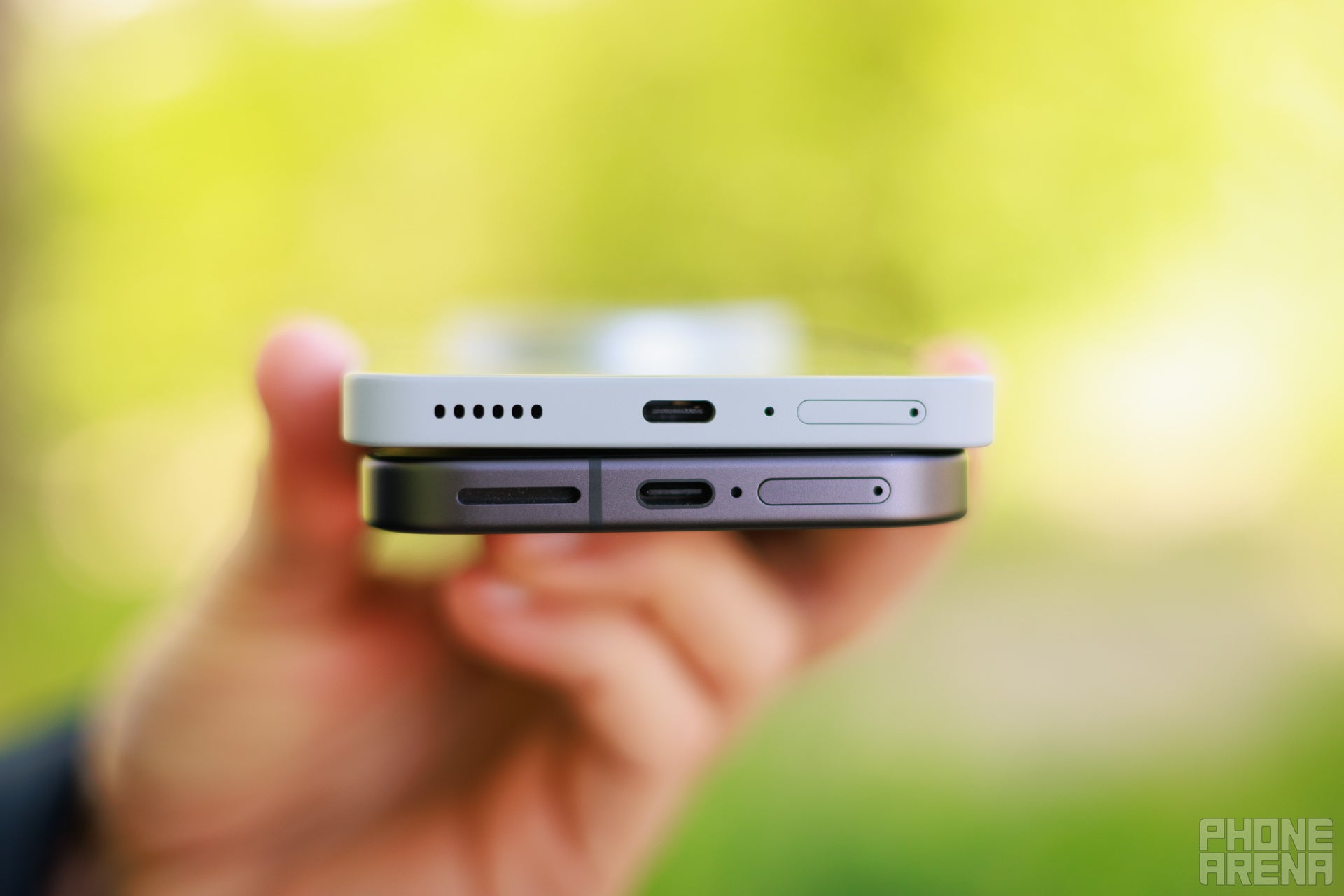
Battery life is a composite metrics, so we need to run our tests to see which one of these will last longer on a single charge. The Snapdragon 7s Gen 3 might be more efficient than the Tensor G4, but on the other hand, the screen of the Nothing Phone (3a) Pro is larger and brighter.
PhoneArena Battery and Charging Test Results:
In terms of charging, the Pixel 9a sadly retains the same slow charging as its predecessor, namely 23W wired charging support and 7.5W wireless. It seems that the Nothing Phone (3a) Pro will be able to topple the Pixel 9a easily when it comes to wired charging, as it supports 50W of charging power. One big drawback (for some people) might be the lack of wireless charging.
Specs Comparison
| Pixel 9a | Nothing Phone (3a) Pro |
|---|---|
| Size, weight 154.7 x 73.3 x 8.9 mm, 186 grams |
Size, weight 163.5 x 77.5 x 8.4 mm, 211 grams |
| Screen 6.3″ OLED 120Hz |
Screen 6.8″ OLED 120Hz |
| Processor Tensor G4 4nm |
Processor Snapdragon 7s Gen 3 4nm |
| Versions: 8/128GB 8/256GB LPDDR5 |
Versions: 12/256GB LPDDR5 |
| Cameras: 48MP main 13MP ultra 13MP front |
Cameras: 50MP main 8MP ultra 50MP periscope telephoto, 3x 12MP front |
| Battery: 5100 mAh |
Battery: 5000 mAh |
| Charging: USB-C 23W wired 7.5W wireless |
Charging: USB-C 50W wired No wireless |
Read more:
Summary

On the other hand, Nothing is starting to expand its lineup and offer more devices. Carl Pei‘s company now has its own A-series, and the Nothing Phone (3a) Pro is the top model in that series. It comes with faster charging (no wireless charging, though), a good main camera, and one additional periscope telephoto system with 3x optical zoom.
Couple all this with the $459 price for the 256GB model and you end up with a very potent mid-ranger. Granted, the phone lacks wireless charging, and its ultrawide camera might not be amazing, plus the Snapdragon 7s Gen 3 is slower than the Tensor G4, but the important boxes seem to be ticked.
At the end of the day, you will be happy with either of these phones, but if you value longevity, you should pick the Pixel 9a for its seven years of software support and all the new and exciting software gimmicks Google might have in store. If camera performance is key, you might be happier with the Nothing Phone (3a) Pro.











